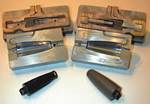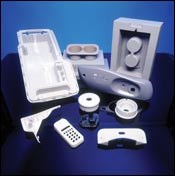Validate the Design First with Rapid Prototyping
Rapid prototyping allows the mold builder to produce a functional model to validate part design, fit and function before the mold is produced.
Transforming plastic part designs into rapid prototypes with full geometry has become an essential part of the moldmaking process for today’s mold builders. Nobody can afford to make mistakes up front, which will take big dollars to fix later. The majority of rapid prototyping involves the use of two common rapid prototyping processes: stereolithography (SLA) and selective laser sintering (SLS).
Both processes produce a solid, three-dimensional part replica that is typically produced from CAD data. The equipment to provide these different processes can be between $300, 000 and $500,000 each, so when moldmakers are searching for a service provider they should seek out companies that have this level of investment and capability.
RP Technologies
Stereolithography is a 3-D layering manufacturing process that applies ultraviolet lasers to cure liquid photopolymer resins to produce solid, plastic, 3-D objects that simulate properties of polyethylene, polypropylene and polycarbonate materials. The SLA machine’s software sections the 3-D CAD model into multiple thin layers (typically five to 10 layers per millimeter). In the SLA machine, the ultraviolet lasers basically paint one of the model layers on the liquid plastic, curing it. The machine drops down a minuscule amount in the liquid, and the laser then paints another layer again. This process is repeated until the model (or stack up of layers) is complete.
Typically the time for this process is six to 12 hours for small to medium sized parts. Accuracy of the machine is approximately ±0.005-inches—depending on part size. Once complete, the parts are finally fully cured in an ultraviolet oven. Typical costs for these services range from $55 to $75/hr depending on part complexity and the material used. More advanced prototyping materials are being developed continuously.
Selective laser sintering (SLS) is another type of prototyping process. With SLS, the model is made from heated powder with a laser that creates the 3-D layers by fusing the particles together. These powdered materials can be nylon, glass-filled nylon, polystyrene or alumide resins. Like SLA, the computer software of the machine takes 3-D data of the part, slices it into layers and laser sinters (melts) the powder, layer by layer. Once one layer is completed, new powder is deposited on top of the solid layer and sintered into another layer. Typical costs for these services range from $55 to $75/hr—depending on part complexity.
SLA and SLS both produce very good prototypes, but their individual application depends on the desired requirements for the final model. For example, if the prototype requires durability and good structural properties for functionality testing and assembly trials, then SLS is the recommended process. If the desire is for a model with excellent finish properties—like an exhibition piece or the part is to be used as a master to produce RTV or epoxy molds—then SLA should be used.
The Process Breakdown
The prototyping process can be broken down into three stages after the initial 3-D CAD design data is submitted:
- Rapid prototype a functional model of the part by either SLA or SLS—depending on requirements.
- Validate the design, fit and finish.
- Either machine the finished mold at that point or produce an RTV silicone or epoxy mold from the master and pour cast urethane to simulate the part. Although there may be some minimal elongation issues, parts produced from cast urethane have good surface quality and will exhibit 85 to 90 percent of the characteristics of the thermoplastic that will ultimately be used for the production parts. Also, with silicone or epoxy molds, B-surface attachments and clips can be molded right in place.
Impact on Mold Building
RP is basically a visual aid that allows the moldmaker to evaluate the design and know it is correct before the process moves to the hard tooling stage. From the model he can accurately determine where parting lines in the mold can and should be set up. If minor modifications need to be made, it can be done to the original SLA master. If they are major modifications, a new master will have to be produced. In either case, it is faster and less costly than modifying hard tools.
To start the rapid prototyping process, .STL files (the file extension that stands for stereolithography), the industry standard for rapid prototyping, are sent to the rapid prototyping source. Most CAD packages (SolidWorks, ProEngineer or Unigraphics) will allow the user to export to the .STL file format. Some CAD packages will let the user preview the .STL file to ensure the output quality.
If the moldmaker does not have a current CAD package that allows .STL files to be exported, then a 3-D CAD drawing can easily be made from blueprints and then converted to the needed .STL file for input to the RP machine. With .STL files in hand, either SLA or SLS prototyping processes can be used—depending on the desired requirements for the final model. For example, if the SLA process is to be used the .STL files will need to be scaled to compensate for mold shrinkage before a master is produced.
Moldmakers find it both cost-effective and comforting to spend only 20 percent of the final mold cost to prove out the fit and function of the design with an RTV molded part, instead of machining a final aluminum mold that may have to be fixed later.
Rapid prototyping allows RP service suppliers to be involved in the whole plastic process, and because some are not design responsible, they give the moldmaker options when they become involved—which is typically after the production part approval process (PPAP).
Some service suppliers provide 1-100 RTV silicone molded prototypes if needed, keeping in mind that these types of silicone molds have a wear life because the material breaks down with time. But, that also depends on the complexity of the part geometry. Or, the service supplier can produce one piece if that validates that the mold will work. Typical turnaround for a rapid prototype is three to five days for either SLA or SLS, but that is dependent upon the geometry and size of the part.
Summary
Rapid prototyping has become an industry within an industry. The processing equipment is unique and costly, and the know-how and experience with respect to CAD, moldmaking, injection molding and the performance and reaction of the prototyping materials, is not quickly learned. This is why one must become educated on the options and strategies involved with this technology, and that is why rapid prototyping services have evolved.
![]()
Related Content
Leading Mold Manufacturers Share Best Practices for Improving Efficiency
Precise Tooling Solutions, X-Cell Tool and Mold, M&M Tool and Mold, Ameritech Die & Mold, and Cavalier Tool & Manufacturing, sit down for a fast-paced Q&A focused on strategies for improving efficiencies across their operations.
Read MoreOEE Monitoring System Addresses Root Cause of Machine Downtime
Unique sensor and patent-pending algorithm of the Amper machine analytics system measures current draw to quickly and inexpensively inform manufacturers which machines are down and why.
Read MoreFour Micro Tooling Considerations
Issues involving gating, ejection, mold splits and direction of pull are of special concern when it comes to micro tooling.
Read MoreHow to Analyze and Optimize Cutting Conditions to Reduce Cycle Time
Plastic injection mold design and manufacturing company puts NC program optimization software module to the test. The results were surprising.
Read MoreRead Next
Rapid Tooling Via Stereolithography Gets a Closer Look
Industry roundtable reports initial findings.
Read MoreAdditive Fabrication Technology
Why you should be aware of it and where it’s headed.
Read MoreDirect Metal Laser Sintering and Tooling
The applications, benefits and limitations of direct metal laser sintering for mold manufacture.
Read More


























